For the month of July, the OISE Library is highlighting a selection of books and resources on Indigenous oral traditions, drama, and Storywork. For the display, we have collected a variety of titles that speak on topics such as Storytelling, Elders’ knowledge, community, and education through oral traditions. In the display, you will find academic materials, children’s literature, activity kits, and curriculum resources to aid in your teaching.
Unipkaaqtuat Arvianit: Traditional Inuit stories from Arviat, by Mark Kalluak
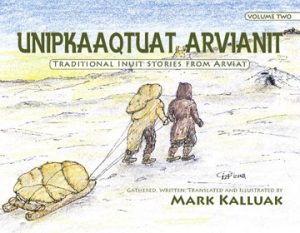 Written in both Inuktitut syllabics and English, Unipkaaqtuat Arvianit: Traditional Inuit stories from Arviat Volume 2 is the second installment of a collection of stories written and illustrated by Mark Kalluak, an Arviat Elder and educator. Mark Kalluak shares a variety of traditional Inuit stories from his childhood, such as The Ingnirjuk, Moon and Sun, The people who turned to stone, Limarasugjuk the people swallower, and many other stories. The goal of this book is to help preserve and promote Inuit oral traditions, stories, language, and knowledge so that they will be shared and passed on to future generations.
Written in both Inuktitut syllabics and English, Unipkaaqtuat Arvianit: Traditional Inuit stories from Arviat Volume 2 is the second installment of a collection of stories written and illustrated by Mark Kalluak, an Arviat Elder and educator. Mark Kalluak shares a variety of traditional Inuit stories from his childhood, such as The Ingnirjuk, Moon and Sun, The people who turned to stone, Limarasugjuk the people swallower, and many other stories. The goal of this book is to help preserve and promote Inuit oral traditions, stories, language, and knowledge so that they will be shared and passed on to future generations.
Raven’s greatest creation: Gaagaagi ogichi-gikendaasowin, by David Bouchard
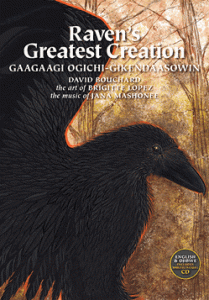 Raven’s greatest creation: Gaagaagi ogichi-gikendaasowin is a dual language book written by award-winning Métis author and Order of Canada recipient, David Bouchard. Through the story, readers learn about Sky World, the Great Waters, and the creation of Turtle Island and its inhabitants. The story tells how Raven created the four-leggeds, flyers, crawlers, and two-leggeds (humankind). The book includes an accompanying CD in both Anishinaabemowin and English, allowing readers to follow along with the story and enjoy the illustrations and music by Cherokee artists Brigitte Lopez and Jana Mashonee.
Raven’s greatest creation: Gaagaagi ogichi-gikendaasowin is a dual language book written by award-winning Métis author and Order of Canada recipient, David Bouchard. Through the story, readers learn about Sky World, the Great Waters, and the creation of Turtle Island and its inhabitants. The story tells how Raven created the four-leggeds, flyers, crawlers, and two-leggeds (humankind). The book includes an accompanying CD in both Anishinaabemowin and English, allowing readers to follow along with the story and enjoy the illustrations and music by Cherokee artists Brigitte Lopez and Jana Mashonee.
Living stories: Godı weghàà ets’ eèda, by Therese Zoe, Philip Zoe and Mindy Willett
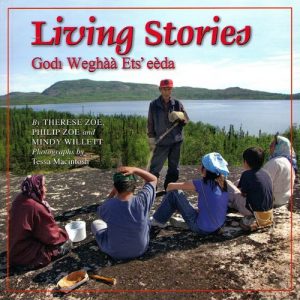 In Living stories: Godı weghàà ets’ eèda, author Therese Zoe translates the stories and traditional knowledge of her family— Tłı̨chǫ Elders Philip Zoe and Elizabeth Chocolate. As a health representative and advocate for story-telling in her community of Gameti, Northwest Territories, Zoe shares sacred stories, wisdom, traditions, and laws of the Tłı̨chǫ. Through the book, readers learn about Tłı̨chǫ history, healing practices, ancestral trails, dry-fish making process, and sacred stories told by Philip Zoe. The goal of the book is to provide some insights into Tłı̨chǫ life today and how these individuals and communities are balancing traditional ways of living and modern technology.
In Living stories: Godı weghàà ets’ eèda, author Therese Zoe translates the stories and traditional knowledge of her family— Tłı̨chǫ Elders Philip Zoe and Elizabeth Chocolate. As a health representative and advocate for story-telling in her community of Gameti, Northwest Territories, Zoe shares sacred stories, wisdom, traditions, and laws of the Tłı̨chǫ. Through the book, readers learn about Tłı̨chǫ history, healing practices, ancestral trails, dry-fish making process, and sacred stories told by Philip Zoe. The goal of the book is to provide some insights into Tłı̨chǫ life today and how these individuals and communities are balancing traditional ways of living and modern technology.
Connective pedagogy: Elder epistemology, oral tradition and community, by Rosemary Ackley Christensen and Lisa M. Poupart
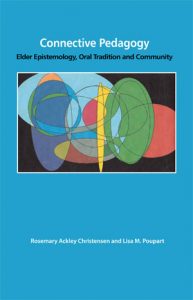 Connective pedagogy: Elder epistemology, oral tradition and community is a collection of oral traditions and teaching methods written by Anishinaabe educator Lisa M. Poupart and Elder Rosemary Ackley Christensen. The goal of the book is to promote inclusivity and celebrate Indigenous teachings. The book explores topics such as the cyclical nature of learning, and the role of elders and the community in education. Grounded in the Anishinaabe idea that teaching and learning are interconnected, Lisa Poupart and Rosemary Christensen share Indigenous teaching methods, tools, and techniques that are based in oral traditions.
Connective pedagogy: Elder epistemology, oral tradition and community is a collection of oral traditions and teaching methods written by Anishinaabe educator Lisa M. Poupart and Elder Rosemary Ackley Christensen. The goal of the book is to promote inclusivity and celebrate Indigenous teachings. The book explores topics such as the cyclical nature of learning, and the role of elders and the community in education. Grounded in the Anishinaabe idea that teaching and learning are interconnected, Lisa Poupart and Rosemary Christensen share Indigenous teaching methods, tools, and techniques that are based in oral traditions.
Someday: A play, by Drew Hayden Taylor
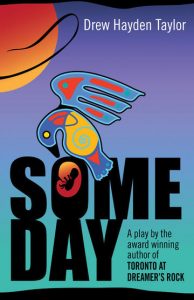 Someday: A play is written by award-winning Anishinaabe playwright Drew Hayden Taylor. Written in the context of the “scoop-up” of the 1950s and 1960s when children were separated from their families, Taylor highlights the tragedies that many communities experienced across Canada. The story follows an Anishinaabe family living in the fictional Otter Lake Reserve in Ontario during Christmas time. With the help of her youngest daughter Barb and her son-in-law Rodney, Anne Wabung attempt to find her daughter Grace who was taken away as a toddler. Taylor seamlessly blends wit and humor to tell an emotional story about family, love, and identity.
Someday: A play is written by award-winning Anishinaabe playwright Drew Hayden Taylor. Written in the context of the “scoop-up” of the 1950s and 1960s when children were separated from their families, Taylor highlights the tragedies that many communities experienced across Canada. The story follows an Anishinaabe family living in the fictional Otter Lake Reserve in Ontario during Christmas time. With the help of her youngest daughter Barb and her son-in-law Rodney, Anne Wabung attempt to find her daughter Grace who was taken away as a toddler. Taylor seamlessly blends wit and humor to tell an emotional story about family, love, and identity.
